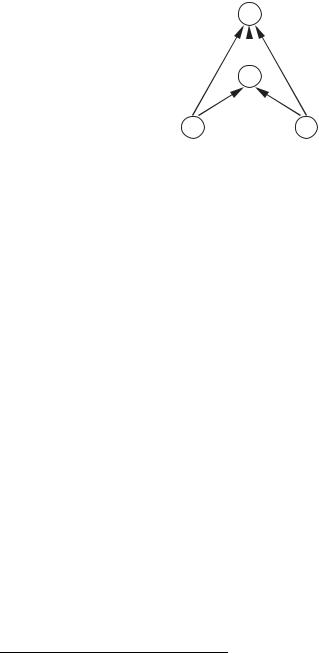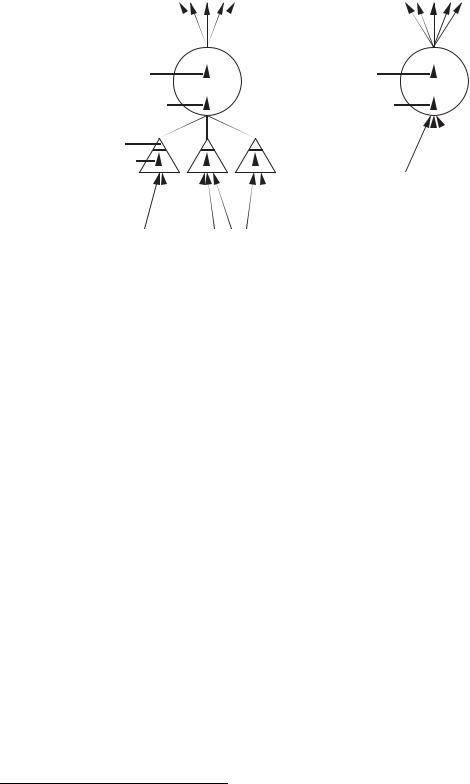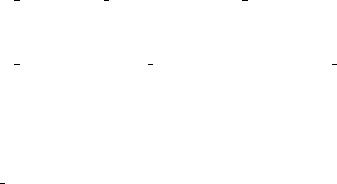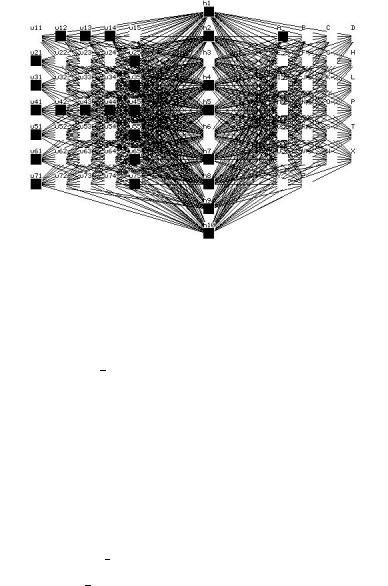
Параллельные Процессы и Параллельное Программирование / SNNSv4.2.Manual
.pdf
3.1. BUILDING BLOCKS OF NEURAL NETS |
19 |
in German, the most comprehensive and up to date book on neural network learning algorithms, simulation systems and neural hardware is probably [Zel94]
A network consists of units1 and directed, weighted links (connections) between them. In analogy to activation passing in biological neurons, each unit receives a net input that is computed from the weighted outputs of prior units with connections leading to this unit. Picture 3.1 shows a small network.
output unit
|
|
11.71 |
|
-5.24 |
|
-5.24 |
hidden unit |
|
|||
|
|
|
6.976.97
input units
Figure 3.1: A small network with three layers of units
The actual information processing within the units is modeled in the SNNS simulator with the activation function and the output function. The activation function rst computes the net input of the unit from the weighted output values of prior units. It then computes the new activation from this net input (and possibly its previous activation). The output function takes this result to generate the output of the unit.2 These functions can be arbitrary C functions linked to the simulator kernel and may be di erent for each unit.
Our simulator uses a discrete clock. Time is not modeled explicitly (i.e. there is no propagation delay or explicit modeling of activation functions varying over time). Rather, the net executes in update steps, where a(t + 1) is the activation of a unit one step after a(t).
The SNNS simulator, just like the Rochester Connectionist Simulator (RCS, [God87]), o ers the use of sites as additional network element. Sites are a simple model of the dendrites of a neuron which allow a grouping and di erent treatment of the input signals of a cell. Each site can have a di erent site function. This selective treatment of incoming information allows more powerful connectionist models. Figure 3.2 shows one unit with sites and one without.
In the following all the various network elements are described in detail.
3.1.1Units
Depending on their function in the net, one can distinguish three types of units: The units whose activations are the problem input for the net are called input units the units
1In the following the more common name "units" is used instead of "cells".
2The term transfer function often denotes the combination of activation and output function. To make matters worse, sometimes the term activation function is also used to comprise activation and output function.

20 |
CHAPTER 3. |
NEURAL NETWORK TERMINOLOGY |
|
unit with sites |
unit without sites |
|
to other units |
to other units |
|
|
output |
output |
||||
output function |
|
|
output function |
|
|
||
|
|
||||||
|
|
activation |
activation |
||||
activation function |
|
|
activation function |
|
|
||
|
|
||||||
site value |
|
|
|
||||
|
|
|
|||||
site function |
|
|
|
|
|
|
|
|
|
|
|
|
|||
|
|
|
|
|
|
|
|
Figure 3.2: One unit with sites and one without
whose output represent the output of the net output units. The remaining units are called hidden units, because they are not visible from the outside (see e.g. gure 3.1).
In most neural network models the type correlates with the topological position of the unit in the net: If a unit does not have input connections but only output connections, then it is an input unit. If it lacks output connections but has input units, it is an output unit. If it has both types of connections it is a hidden unit.
It can, however, be the case that the output of a topologically internal unit is regarded as part of the output of the network. The IO-type of a unit used in the SNNS simulator has to be understood in this manner. That is, units can receive input or generate output even if they are not at the fringe of the network.
Below, all attributes of a unit are listed:
no: For proper identi cation, every unit has a number3 attached to it. This number de nes the order in which the units are stored in the simulator kernel.
name: The name can be selected arbitrarily by the user. It must not, however, contain blanks or special characters, and has to start with a letter. It is useful to select a short name that describes the task of the unit, since the name can be displayed with the network.
io-type or io: The IO-type de nes the function of the unit within the net. The following alternatives are possible
{input : input unit
{output: output unit
{dual : both input and output unit
3This number can change after saving but remains unambiguous. See also chapter 4.3.2.1

3.1. BUILDING BLOCKS OF NEURAL NETS |
21 |
{hidden: internal, i.e. hidden unit
{special: this type can be used in any way, depending upon the application. In the standard version of the SNNS simulator, the weights to such units are not adapted in the learning algorithm (see paragraph 3.3).
{special input, special hidden, special output: sometimes it is necessary to to know where in the network a special unit is located. These three types enable the correlation of the units to the various layers of the network.
activation: The activation value.
initial activation or i act: This variable contains the initial activation value, present after the initial loading of the net. This initial con guration can be reproduced by resetting (reset ) the net, e.g. to get a de ned starting state of the net.
output: the output value.
bias: In contrast to other network simulators where the bias (threshold) of a unit is simulated by a link weight from a special 'on'-unit, SNNS represents it as a unit parameter. In the standard version of SNNS the bias determines where the activation function has its steepest ascent. (see e.g. the activation function Act logistic). Learning procedures like backpropagation change the bias of a unit like a weight during training.
activation function or actFunc: A new activation is computed from the output of preceding units, usually multiplied by the weights connecting these predecessor units with the current unit, the old activation of the unit and its bias. When sites are being used, the network input is computed from the site values. The general formula is:
aj(t + 1) = fact(netj(t) aj (t) j)
where:
aj(t) activation of unit j in step t netj (t) net input in unit j in step tj threshold (bias) of unit j
The SNNS default activation function Act logistic, for example, computes the network input simply by summing over all weighted activations and then squashing the
result with the logistic function fact(x) = 1=(1 + e;x). The new activation at time (t + 1) lies in the range [0 1]4. The variable j is the threshold of unit j.
The net input netj(t) is computed with
netj(t) |
= |
wijoi(t) |
if unit j has no sites |
|
|
|
i |
|
|
netj(t) |
= |
Xsjk(t) |
if the unit j has sites, with site values |
|
|
|
k |
|
|
|
|
X |
|
|
4Mathematically correct would be ]0 1[, but the values 0 and 1 are reached due to arithmetic inaccuracy.

22 CHAPTER 3. NEURAL NETWORK TERMINOLOGY
sjk(t) = |
X |
wijoi(t) |
|
i |
|
This yields the well-known logistic activation function
1
aj (t + 1) = 1 + e;(Pi wij oi(t); j )
where:
aj(t) activation of unit j in step t netj(t) net input in unit j in step t oi(t) output of unit i in step t
sjk(t) site value of site k on unit j in step t
jindex for some unit in the net
i index of a predecessor of the unit j
kindex of a site of unit j
wij weight of the link from unit i to unit jj threshold (bias) of unit j
Activation functions in SNNS are relatively simple C functions which are linked to the simulator kernel. The user may easily write his own activation functions in C and compile and link them to the simulator kernel. How this can be done is described later.
output function or outFunc: The output function computes the output of every unit from the current activation of this unit. The output function is in most cases the identity function (SNNS: Out identity). This is the default in SNNS. The output function makes it possible to process the activation before an output occurs.
where:
aj(t) oj (t) j
oj(t) = fout(aj(t))
Activation of unit j in step t
Output of unit j in step t
Index for all units of the net
Another prede ned SNNS-standard function, Out Clip01 clips the output to the range of [0::1] and is de ned as follows:
oj(t) = 8 |
0 |
if aj(t) < 0 |
1 |
if aj(t) > 1 |
|
> a (t) |
otherwise |
|
< |
j |
|
>:
Output functions are even simpler C functions than activation functions and can be user-de ned in a similar way.

3.1. BUILDING BLOCKS OF NEURAL NETS |
23 |
f-type: The user can assign so called f-types (functionality types, prototypes) to a unit. The unusual name is for historical reasons. One may think of an f-type as a pointer to some prototype unit where a number of parameters has already been de ned:
{activation function and output function
{whether sites are present and, if so, which ones
These types can be de ned independently and are used for grouping units into sets of units with the same functionality. All changes in the de nition of the f-type consequently a ect also all units of that type. Therefore a variety of changes becomes possible with minimum e ort.
position: Every unit has a speci c position (coordinates in space) assigned to it. These positions consist of 3 integer coordinates in a 3D grid. For editing and 2D visualization only the rst two (x and y) coordinates are needed, for 3D visualization of the networks the z coordinate is necessary.
subnet no: Every unit is assigned to a subnet. With the use of this variable, structured nets can be displayed more clearly than would otherwise be possible in a 2D presentation.
layers: Units can be visualized in 2D in up to 8 layers5. Layers can be displayed selectively. This technique is similar to a presentation with several transparencies, where each transparency contains one aspect or part of the picture, and some or all transparencies can be selected to be stacked on top of each other in a random order. Only those units which are in layers (transparencies) that are 'on' are displayed. This way portions of the network can be selected to be displayed alone. It is also possible to assign one unit to multiple layers. Thereby it is feasible to assign any combination of units to a layer that represents an aspect of the network.
frozen: This attribute ag speci es that activation and output are frozen. This means that these values don't change during the simulation.
All `important' unit parameters like activation, initial activation, output etc. and all function results are computed as oats with nine decimals accuracy.
3.1.2Connections (Links)
The direction of a connection shows the direction of the transfer of activation. The unit from which the connection starts is called the source unit, or source for short, while the other is called the target unit , or target. Connections where source and target are identical (recursive connections) are possible. Multiple connections between one unit and the same input port of another unit are redundant, and therefore prohibited. This is checked by SNNS.
Each connection has a weight (or strength) assigned to it. The e ect of the output of one unit on the successor unit is de ned by this value: if it is negative, then the connection
5Changing it to 16 layers can be done very easily in the source code of the interface.
24 |
CHAPTER 3. NEURAL NETWORK TERMINOLOGY |
is inhibitory, i.e. decreasing the activity of the target unit if it is positive, it has an excitatory, i.e. activity enhancing, e ect.
The most frequently used network architecture is built hierarchically bottom-up. The input into a unit comes only from the units of preceding layers. Because of the unidirectionalow of information within the net they are also called feed-forward nets (as example see the neural net classi er introduced in chapter 3.5). In many models a full connectivity between all units of adjoining levels is assumed.
Weights are represented as oats with nine decimal digits of precision.
3.1.3Sites
A unit with sites doesn't have a direct input any more. All incoming links lead to di erent sites, where the arriving weighted output signals of preceding units are processed with di erent user-de nable site functions (see picture 3.2). The result of the site function is represented by the site value. The activation function then takes this value of each site as network input.
The SNNS simulator does not allow multiple connections from a unit to the same input port of a target unit. Connections to di erent sites of the same target units are allowed. Similarly, multiple connections from one unit to di erent input sites of itself are allowed as well.
3.2Update Modes
To compute the new activation values of the units, the SNNS simulator running on a sequential workstation processor has to visit all of them in some sequential order. This order is de ned by the Update Mode. Five update modes for general use are implemented in SNNS. The rst is a synchronous mode, all other are asynchronous, i.e. in these modes units see the new outputs of their predecessors if these have red before them.
1.synchronous: The units change their activation all together after each step. To do this, the kernel rst computes the new activations of all units from their activation functions in some arbitrary order. After all units have their new activation value assigned, the new output of the units is computed. The outside spectator gets the impression that all units have red simultaneously (in sync).
2.random permutation: The units compute their new activation and output function sequentially. The order is de ned randomly, but each unit is selected exactly once in every step.
3.random: The order is de ned by a random number generator. Thus it is not guaranteed that all units are visited exactly once in one update step, i.e. some units may be updated several times, some not at all.
4.serial : The order is de ned by ascending internal unit number. If units are created with ascending unit numbers from input to output units, this is the fastest mode.

3.3. LEARNING IN NEURAL NETS |
25 |
Note that the use of serial mode is not advisable if the units of a network are not in ascending order.
5.topological: The kernel sorts the units by their topology. This order corresponds to the natural propagation of activity from input to output. In pure feed-forward nets the input activation reaches the output especially fast with this mode, because many units already have their nal output which doesn't change later.
Additionally, there are 12 more update modes for special network topologies implemented in SNNS.
1.CPN : For learning with counterpropagation.
2.Time Delay: This mode takes into account the special connections of time delay networks. Connections have to be updated in the order in which they become valid in the course of time.
3.ART1 Stable, ART2 Stable and ARTMAP Stable: Three update modes for the three adaptive resonance theory network models. They propagate a pattern through the network until a stable state has been reached.
4.ART1 Synchronous, ART2 Synchronous and ARTMAP Synchronous: Three other update modes for the three adaptive resonance theory network models. They perform just one propagation step with each call.
5.CC : Special update mode for the cascade correlation meta algorithm.
6.BPTT : For recurrent networks, trained with `backpropagation through time'.
7.RM Synchronous: Special update mode for auto-associative memory networks.
Note, that all update modes only apply to the forward propagation phase, the backward phase in learning procedures like backpropagation is not a ected at all.
3.3Learning in Neural Nets
An important focus of neural network research is the question of how to adjust the weights of the links to get the desired system behavior. This modi cation is very often based on the Hebbian rule, which states that a link between two units is strengthened if both units are active at the same time. The Hebbian rule in its general form is:
|
wij = g(aj (t) tj)h(oi (t) wij) |
where: |
|
wij |
weight of the link from unit i to unit j |
aj (t) |
activation of unit j in step t |
tj |
teaching input, in general the desired output of unit j |
oi(t) |
output of unit i at time t |

26 |
CHAPTER 3. NEURAL NETWORK TERMINOLOGY |
g(: : :) function, depending on the activation of the unit and the teaching input h(: : :) function, depending on the output of the preceding element and the current
weight of the link
Training a feed-forward neural network with supervised learning consists of the following procedure:
An input pattern is presented to the network. The input is then propagated forward in the net until activation reaches the output layer. This constitutes the so called forward propagation phase.
The output of the output layer is then compared with the teaching input. The error, i.e. the di erence (delta) j between the output oj and the teaching input tj of a target output unit j is then used together with the output oi of the source unit i to compute the necessary changes of the link wij . To compute the deltas of inner units for which no teaching input is available, (units of hidden layers) the deltas of the following layer, which are already computed, are used in a formula given below. In this way the errors (deltas) are propagated backward, so this phase is called backward propagation.
In online learning, the weight changes wij are applied to the network after each training pattern, i.e. after each forward and backward pass. In o ine learning or batch learning the weight changes are cumulated for all patterns in the training le and the sum of all changes is applied after one full cycle (epoch) through the training pattern le.
The most famous learning algorithm which works in the manner described is currently backpropagation. In the backpropagation learning algorithm online training is usually signi cantly faster than batch training, especially in the case of large training sets with many similar training examples.
The backpropagation weight update rule, also called generalized delta-rule reads as follows:
wij |
= |
j |
oi |
|
j |
= |
fj0 |
(netj)(tj ; oj) |
if unit j is a output-unit |
where: |
|
( fj0 |
(netj) Pk kwjk |
if unit j is a hidden-unit |
learning factor eta (a constant)
j error (di erence between the real output and the teaching input) of unit j tj teaching input of unit j
oi output of the preceding unit i
i index of a predecessor to the current unit j with link wij from i to j
jindex of the current unit
kindex of a successor to the current unit j with link wjk from j to k
There are several backpropagation algorithms supplied with SNNS: one \vanilla backpropagation" called Std Backpropagation, one with momentum term and at spot elimination called BackpropMomentum and a batch version called BackpropBatch. They can be chosen from the control panel with the button OPTIONS and the menu selection select learning function.

3.4. GENERALIZATION OF NEURAL NETWORKS |
27 |
In SNNS, one may either set the number of training cycles in advance or train the network until it has reached a prede ned error on the training set.
3.4Generalization of Neural Networks
Figure 3.3: Error development of a training and a validation set
One of the major advantages of neural nets is their ability to generalize. This means that a trained net could classify data from the same class as the learning data that it has never seen before. In real world applications developers normally have only a small part of all possible patterns for the generation of a neural net. To reach the best generalization, the dataset should be split into three parts:
The training set is used to train a neural net. The error of this dataset is minimized during training.
The validation set is used to determine the performance of a neural network on patterns that are not trained during learning.
A test set for nally checking the over all performance of a neural net.
Figure 3.3 shows a typical error development of a training set (lower curve) and a validation set (upper curve).
The learning should be stopped in the minimum of the validation set error. At this point the net generalizes best. When learning is not stopped, overtraining occurs and the performance of the net on the whole data decreases, despite the fact that the error on the training data still gets smaller. After nishing the learning phase, the net should benally checked with the third data set, the test set.
SNNS performs one validation cycle every n training cycles. Just like training, validation is controlled from the control panel.

28 |
CHAPTER 3. NEURAL NETWORK TERMINOLOGY |
3.5An Example of a simple Network
Figure 3.4: Example network of the letter classi er
This paragraph describes a simple example network, a neural network classi er for capital letters in a 5x7 matrix, which is ready for use with the SNNS simulator. Note that this is a toy example which is not suitable for real character recognition.
Network-Files: letters untrained.net, letters.net (trained)
Pattern-File: letters.pat
The network in gure 3.4 is a feed-forward net with three layers of units (two layers of weights) which can recognize capital letters. The input is a 5x7 matrix, where one unit is assigned to each pixel of the matrix. An activation of +1:0 corresponds to \pixel set", while an activation value of 0:0 corresponds to \pixel not set". The output of the network consists of exactly one unit for each capital letter of the alphabet.
The following activation function and output function are used by default:
Activation function: Act logistic
Output function: Out identity
The net has one input layer (5x7 units), one hidden layer (10 units) and one output layer (26 units named 'A' . . . 'Z'). The total of (35 10 + 10 26) = 610 connections form the distributed memory of the classi er.
On presentation of a pattern that resembles the uppercase letter \A", the net produces as output a rating of which letters are probable.
